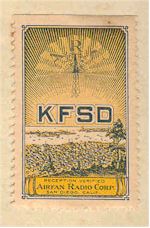Scottie Rice reminds us that the radio station known as KOGO began broadcasting on June 30, 1925, and that makes it 100 years old. According to Wikipedia, the station started as KFWV on 1220 kHz, likely an alphabetically-issued callsign. It operated out of the U.S. Grant Hotel in downtown San Diego.
According to FCC documents, in 1926, the callsign changed to KFSD. In 1927, the station was granted a change to 680 kHz at 500 watts power. In November 1928, KFSD moved to 600 kHz with 1 kW output power days and 500 watts nights.
In the 1930s, the station was owned by the Airfan Radio Corporation. It became an NBC Red Network affiliate in 1931.
In 1948, KFSD moved its studios to Emerald Hills, east of downtown San Diego, at the site of a former country club, and increased power to 5 kW day and night. The facility housed KFSD’s studios, transmitter, and offices. That same year, San Diego’s first FM station, KFSD-FM 94.1 MHz (now KMYI), signed on from Emerald Hills.
In 1961, the station changed its callsign to KOGO at the same time the AM, TV, and FM properties were sold to Time Life Broadcasting, where the stations shared studios at what is now KGTV near the intersection of I-805 and CA-94. In 1972, KOGO-AM was sold to Retlaw Enterprises, owned by the Walt Disney family (Retlaw is “Walter” in reverse).
KOGO went through a number of changes in ownership, callsigns, and formats, but settled into a talk format in April 1994 with Par Broadcasting. Par sold the station to Jacor in 1997, which later merged with Clear Channel Communications, becoming iHeartMedia in 2014.
KOGO moved to colocate its transmission site with KGB 760 in November of 2024. With the shorter towers (69°), the output power is now 9 kW (10kW night) and is directional to the southwest. The old Emerald Hills site is due to be abandoned, but some FM broadcasters must still move to the KGB-FM site before the towers are destroyed.
I heard a couple of stories about KFSD in the late 1920s from an elderly neighbor named Art Nolan who lived nearby us in North Park in 1992. As a young man, he was assigned the evening shift at KFSD downtown. He told me he got a complaint from an avid listener of KFI 640 that KFSD was interfering with their signal. Sure enough, when he measured their frequency with a wavemeter, KFSD had wandered from its assigned 680 to near 640 kHz, and Art had to adjust the frequency back up. The FCC coincidentally required crystal frequency control soon thereafter.
Art told me he was fired from KFSD when he was caught signing off the transmitter a few minutes early so that he could catch the last ferry of the day to his home in Coronado. His career didn’t suffer greatly because he soon began working as a navigator for Pan American Airlines on their trans-Pacific routes.

